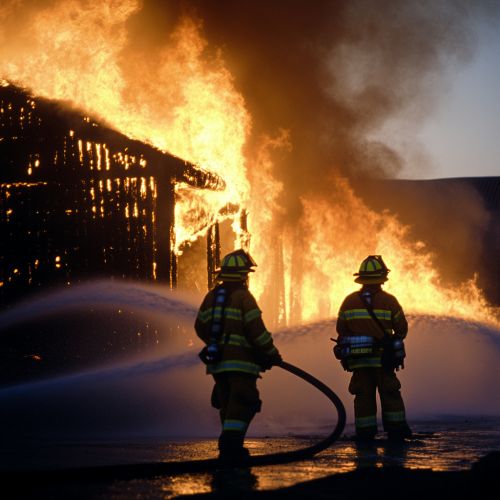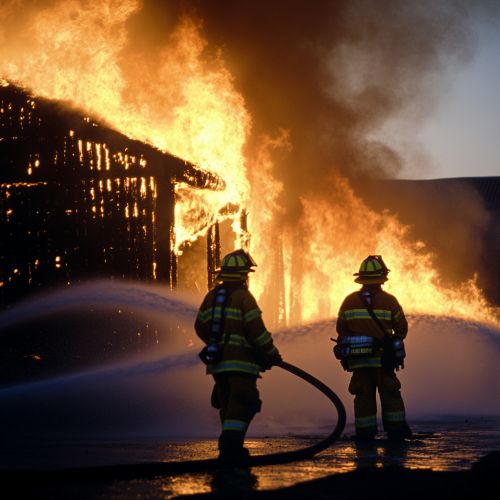Fire Dynamics: Difference between revisions
(Created page with "== Introduction == Fire dynamics is the study of how fires start, spread, and develop. This field encompasses the physical and chemical processes that govern fire behavior, including ignition, flame spread, heat release, and smoke production. Understanding fire dynamics is crucial for fire safety engineering, firefighting strategies, and the design of fire protection systems. == Fundamentals of Fire == Fire is a rapid oxidation process that releases heat, light, and var...") |
No edit summary |
||
| Line 100: | Line 100: | ||
* [[Fire Risk Assessment]] | * [[Fire Risk Assessment]] | ||
[[Image:Detail-97717.jpg|thumb|center|Firefighters extinguishing a building fire.|class=only_on_mobile]] | |||
[[Image:Detail-97718.jpg|thumb|center|Firefighters extinguishing a building fire.|class=only_on_desktop]] | |||
[[Category:Fire Dynamics]] | [[Category:Fire Dynamics]] | ||
[[Category:Combustion]] | [[Category:Combustion]] | ||
[[Category:Fire Safety Engineering]] | [[Category:Fire Safety Engineering]] | ||
Latest revision as of 20:48, 19 August 2024
Introduction
Fire dynamics is the study of how fires start, spread, and develop. This field encompasses the physical and chemical processes that govern fire behavior, including ignition, flame spread, heat release, and smoke production. Understanding fire dynamics is crucial for fire safety engineering, firefighting strategies, and the design of fire protection systems.
Fundamentals of Fire
Fire is a rapid oxidation process that releases heat, light, and various reaction products. The fundamental components of fire are fuel, heat, and oxygen, commonly referred to as the fire triangle. The interaction of these components leads to combustion, which can be either flaming or smoldering.
Combustion Process
Combustion is a complex sequence of exothermic chemical reactions between a fuel and an oxidant. The process can be divided into several stages:
- **Pre-ignition**: The fuel is heated, causing it to decompose and release volatile gases.
- **Ignition**: The mixture of fuel gases and oxygen reaches a temperature where it can ignite.
- **Flaming Combustion**: A sustained reaction occurs, producing flames.
- **Smoldering Combustion**: A slower, flameless form of combustion that occurs on the surface of the fuel.
Heat Transfer Mechanisms
Heat transfer is a critical aspect of fire dynamics, influencing how fires spread and develop. The primary mechanisms of heat transfer are conduction, convection, and radiation.
Conduction
Conduction is the transfer of heat through a solid material. In the context of fire, conduction can cause heat to spread through building materials, potentially igniting adjacent areas.
Convection
Convection involves the transfer of heat by the movement of fluids, such as air or water. In fires, convection currents can carry hot gases and smoke, spreading heat throughout a structure.
Radiation
Radiation is the transfer of heat through electromagnetic waves. Radiant heat can ignite materials at a distance from the flame, contributing to the spread of fire.
Flame Spread
Flame spread is the movement of flames over the surface of a fuel. Several factors influence flame spread, including the properties of the fuel, the availability of oxygen, and the heat transfer mechanisms.
Fuel Properties
The type of fuel, its physical state (solid, liquid, or gas), and its chemical composition all affect flame spread. For example, flammable liquids can spread flames more rapidly than solid materials.
Oxygen Availability
The concentration of oxygen in the environment influences the rate of combustion. Higher oxygen levels can accelerate flame spread, while lower levels can slow it down.
Heat Transfer
The efficiency of heat transfer mechanisms also plays a role in flame spread. Effective conduction, convection, and radiation can increase the rate at which flames move across a surface.
Heat Release Rate
The heat release rate (HRR) is a measure of the energy output of a fire. It is a critical parameter in fire dynamics, as it influences the fire's growth, intensity, and potential for spread.
Measuring HRR
HRR can be measured using calorimetry, which quantifies the amount of heat produced by a fire. This information is essential for assessing fire hazards and designing fire protection systems.
Factors Affecting HRR
Several factors can influence HRR, including the type of fuel, the size of the fire, and the ventilation conditions. Understanding these factors helps predict the behavior of fires in different scenarios.
Smoke Production
Smoke is a byproduct of combustion and consists of a complex mixture of gases, vapors, and particulate matter. The production and movement of smoke are critical considerations in fire dynamics, as smoke can pose significant health and visibility hazards.
Composition of Smoke
Smoke contains a variety of chemical compounds, including carbon monoxide, carbon dioxide, and various hydrocarbons. The specific composition depends on the type of fuel and the conditions of combustion.
Smoke Movement
The movement of smoke is influenced by convection currents, building geometry, and ventilation. Smoke can spread rapidly through a structure, reducing visibility and posing inhalation risks.
Fire Growth and Development
The growth and development of a fire are influenced by the interactions between fuel, heat, and oxygen. Fire growth can be divided into several stages: ignition, growth, fully developed, and decay.
Ignition
Ignition is the initial stage of a fire, where a heat source causes the fuel to reach its ignition temperature. This can occur through various means, such as open flames, electrical sparks, or chemical reactions.
Growth
During the growth stage, the fire spreads and increases in intensity. The availability of fuel and oxygen, as well as the efficiency of heat transfer mechanisms, influence the rate of growth.
Fully Developed
In the fully developed stage, the fire reaches its peak intensity, consuming the maximum amount of fuel and releasing the highest amount of heat. This stage is characterized by high temperatures and rapid flame spread.
Decay
The decay stage occurs as the fuel is consumed, and the fire's intensity decreases. The rate of decay depends on the remaining fuel and the availability of oxygen.
Fire Suppression
Fire suppression involves the use of various techniques and agents to extinguish a fire. The primary methods of fire suppression are cooling, smothering, and chemical inhibition.
Cooling
Cooling involves reducing the temperature of the fuel and surrounding materials to below the ignition point. Water is the most common cooling agent used in firefighting.
Smothering
Smothering removes or displaces oxygen, preventing the combustion process. This can be achieved using foam, carbon dioxide, or other inert gases.
Chemical Inhibition
Chemical inhibition involves the use of agents that interfere with the chemical reactions of combustion. Halons and other chemical suppressants can effectively inhibit the fire's growth.
Fire Safety Engineering
Fire safety engineering is the application of scientific and engineering principles to protect people, property, and the environment from fire. This field encompasses the design of fire protection systems, fire risk assessment, and the development of fire safety regulations.
Fire Protection Systems
Fire protection systems include active and passive measures designed to detect, control, and extinguish fires. Examples include fire alarms, sprinklers, fire-resistant materials, and compartmentation.
Fire Risk Assessment
Fire risk assessment involves evaluating the potential hazards and risks associated with fire in a particular environment. This process includes identifying ignition sources, assessing fuel loads, and analyzing potential fire scenarios.
Fire Safety Regulations
Fire safety regulations establish the minimum requirements for fire protection in buildings and other structures. These regulations are based on scientific research and are enforced by governmental agencies to ensure public safety.
See Also


